
Conflict of Heroes: Storms of Steel, the second installment of the Conflict of Heroes board wargame series by Academy Games, was published in 2009. The game simulates the Battle of Kursk on the Eastern Front during World War II.

Conflict of Heroes: Storms of Steel, the second installment of the Conflict of Heroes board wargame series by Academy Games, was published in 2009. The game simulates the Battle of Kursk on the Eastern Front during World War II.
In July 1943, German forces launched Operation Citadel in an attempt to pinch off a Soviet salient near the city of Kursk and blunt an expected Soviet offensive, but the German attack encountered strong and well-prepared defenses. With the unexpected and almost simultaneous Allied invasion of Sicily, Operation Citadel was called off after only a week in order to divert resources to Italy. Soviet forces then launched a counteroffensive, Operation Polkovodets Rumyantsev, that successfully forced the Germans into a retreat.
Conflict of Heroes: Storms of Steel is a 2-player simulation of the various encounters and engagements during the Battle of Kursk.
The game box contains:
To start a round, Combat Cards are dealt to both players. The players roll for initiative. The player who wins initiative can either choose to activate a unit or let the opponent activate a unit. The selected unit then uses up to seven Action Points to perform an action:
After the unit has completed that action, the active player rolls a Spent Die to see if the unit is Stressed and Spent; the only action a Stressed unit can take for the rest of the round is to defend if attacked.
Once all units have had an action, the round is over.
Academy Games published the board wargame Conflict of Heroes: Awakening the Bear! in 2009, and followed this up with the sequel Conflict of Heroes: Storms of Steel, which was designed by Uwe Eickert, with artwork by Steve Paschal. Academy Games produced a second edition of the game, but called it "Third Edition", since it used a set of revised rules that had been designed for the Third Edition of Conflict of Heroes: Awakening the Bear!
Reviewing the Third Edition, Robert Peterson liked everything about the components, stating, "Everything about the components is meant to thrill a wargamer." He found the large 1" counters much easier to handle and read than industry-standard 1/2" counters. He found the rules easy to digest and well-written. He also liked the gradual rules introduction where only a few rules were needed to play the first scenario, then more rules were added for each successive scenario. "So, by the end of the Rulebook you are thoroughly prepared to play any scenario that comes with the game." Peterson concluded with a strong recommendation for a game that is "not a rule heavy monster." [1]
Richard Martin, writing for Armchair General, liked the "beautiful components", especially the large "easy to pick up" counters. However, he noted the lack of counters to mark wrecked vehicles, the lack of statistics necessary for players to design their own scenarios, and some rules that needed clarification. He concluded by giving the game an almost perfect rating of 99 out of 100, saying, "These few quibbles notwithstanding, Conflict of Heroes: Storms of Steel is a must have for World War 2 gamers who crave tactical battle action and is, quite simply, a triumph of game design! Get this game! Schnell! Schnell!" [2]

A wargame is a strategy game in which two or more players command opposing armed forces in a simulation of an armed conflict. Wargaming may be played for recreation, to train military officers in the art of strategic thinking, or to study the nature of potential conflicts. Many wargames re-create specific historic battles, and can cover either whole wars, or any campaigns, battles, or lower-level engagements within them. Many simulate land combat, but there are wargames for naval, air combat, and cyber as well as many that combine various domains.
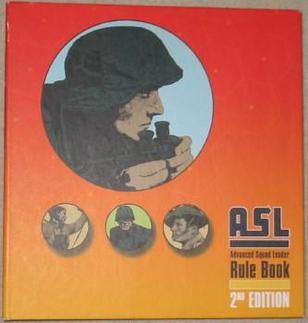
Advanced Squad Leader (ASL) is a tactical-level board wargame, originally marketed by Avalon Hill Games, that simulates actions of squad sized units in World War II. It is a detailed game system for two or more players. Components include the ASL Rulebook and various games called modules. ASL modules provide the standard equipment for playing ASL, including geomorphic mapboards and counters. The mapboards are divided into hexagons to regulate fire and movement, and depict generic terrain that can represent different historical locations. The counters are cardboard pieces that depict squads of soldiers, crews, individual leaders, support weapons, heavy weapons, and vehicles.
Federation and Empire (F&E) is a strategic-level board wargame set in the fictional Star Fleet Universe spinoff of Star Trek, currently published by Amarillo Design Bureau Inc. (ADB). It is a stand-alone product, but has sometimes been considered the official campaign generator for Star Fleet Battles.

White Bear and Red Moon is a fantasy board wargame set in the world of Glorantha, created by Greg Stafford and published in 1975. Stafford first tried to sell the game to established publishers, but despite being accepted by three different game companies, each attempt ended in failure; eventually he founded his own game company in 1974, the influential Chaosium, to produce and market the game.

Squad Leader is a tactical level board war game originally published by Avalon Hill in 1977. It was designed by John Hill and simulates on infantry combat in Europe during World War II. One of the most complex war games of its time, Squad Leader is the natural extension of the trend towards greater realism initiated by several earlier games, including Avalon Hill's own PanzerBlitz and Panzer Leader. Those two earlier games were slightly larger in scope, with counters representing platoons and map hexes measuring 250 metres across, compared to Squad Leader's 40 meter hexes and squad sized units.
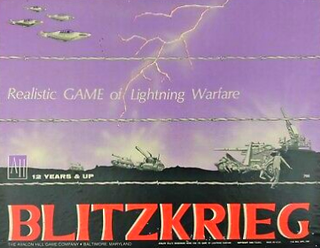
Blitzkrieg is a strategic-level wargame published by Avalon Hill in 1965 that simulates a non-historical attack by one major power against another using the blitzkrieg strategy. It was the first commercial wargame that did not simulate an actual historical battle, and with almost 400 counters, it was a precursor to the "monster" wargames of the 1970s featuring more than a thousand counters.
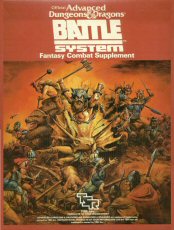
Battlesystem is a tabletop miniature wargame designed as a supplement for use with the Dungeons & Dragons role-playing game. The original Battlesystem was printed as a boxed set in 1985 for use with the first edition AD&D rules. For the second edition of AD&D, a new version of Battesystem was printed as a softcover book in 1989.

Battle of the Bulge is a board wargame published by Avalon Hill (AH) in 1965 that simulates the World War II battle of the same name. General Anthony McAuliffe (ret.), who had been commanding officer at Bastogne during the Battle of the Bulge, was a consultant during the game's development. The game proved popular and sold more than 120,000 copies, but was dogged by criticisms of historical inaccuracies, and was finally replaced by a completely new edition in 1981. A third edition in 1991 was released as part of the Smithsonian American History Series.
Sniper!, subtitled "House-to-House Fighting in World War II", is a two-player board wargame about man-to-man combat in urban environments during WWII, originally released in 1973 by Simulations Publications Inc. (SPI). After TSR purchased SPI in 1982, TSR released an expanded edition of Sniper! in 1986, and followed up that up with releases of various "companion games" and a videogame.
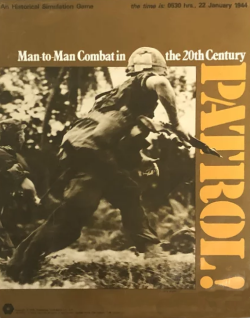
Patrol, subtitled "Man to Man Combat in the 20th Century", is a skirmish-level board wargame published by Simulations Publications Inc. (SPI) in 1974 as a sequel to Sniper!, which had been released the previous year. Whereas Sniper! was set in urban environments during the Second World War, Patrol is set in a non-urban environment, in various conflicts ranging from 1914 to 1970.

Chinese Farm, subtitled "Egyptian-Israeli Combat in the '73 War", is a board wargame published by Simulations Publications, Inc. (SPI) in 1975 that simulates operational level ground combat between Egypt and Israel at the Battle of The Chinese Farm during the just completed Yom Kippur War of October 1973. Chinese Farm was originally published as part of the "quadrigame" Modern Battles: Four Contemporary Conflicts.

Tobruk, subtitled "Tank Battles in North Africa 1942", is a board wargame published by Avalon Hill in 1975 that simulates tank combat in North Africa during World War II.

Golan subtitled "Syrian-Israeli Combat in the '73 War", is a board wargame published by Simulations Publications, Inc. (SPI) in 1975 that simulates operational level ground combat between Egypt and Israel on the Golan Heights during the just completed Yom Kippur War of October 1973. Golan was originally published as part of the "quadrigame" Modern Battles: Four Contemporary Conflicts.

A board wargame is a wargame with a set playing surface or board, as opposed to being played on a computer or in a more free-form playing area as in miniatures games. The modern, commercial wargaming hobby developed in 1954 following the publication and commercial success of Tactics. The board wargaming hobby continues to enjoy a sizeable following, with a number of game publishers and gaming conventions dedicated to the hobby both in the English-speaking world and further afield.
Conflict of Heroes (CoH) is a tactical-level board wargame series that simulates firefights at the platoon or company level. Several games and expansions have been released in the series including, Price of Honour set in Poland in 1939, Awakening the Bear!, set in the World War II Eastern Front between the years 1941 and 1942, Storms of Steel, set in Kursk in 1943 and Guadalcanal, set on Guadalcanal in 1942. The game is played on one or more interchangeable map boards which are divided into hexagons for movement and firing regulation.

Conflict of Heroes: Awakening the Bear! is a board wargame published by Academy Games in 2008 that simulates squad-level and platoon-level combat on the Eastern Front in 1941–42 during the German invasion of the Soviet Union during World War II. The game won several industry awards, and was the first in a series of games in the Conflict of Heroes series.
La Bataille de la Moscowa is a board wargame published originally by Martial Enterprises in 1975, later republished by Game Designers Workshop in 1977, and by Clash of Arms in 2011.

The Great Patriotic War: Nazi Germany vs. the Soviet Union is a board game published by Game Designers' Workshop (GDW) in 1988 that simulates conflict between Germany and the Soviet Union in World War II.
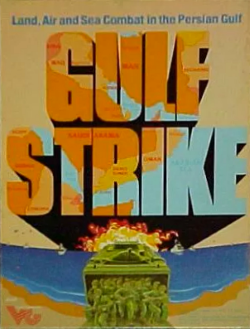
Gulf Strike, subtitled "Land, Air and Sea Combat in the Persian Gulf", is a board wargame published by Victory Games in 1983. The first and second editions were hypothetical games focussed on American responses to Iranian aggression in the Persian Gulf. The third edition, published in 1990, was updated to reflect the reality of Operation Desert Shield during the Gulf War.

Kursk: Operation Zitadelle is a board wargame published by Simulations Publications Inc. (SPI) in 1971. It was the first wargame to simulate the Battle of Kursk, the large tank battle during World War II.